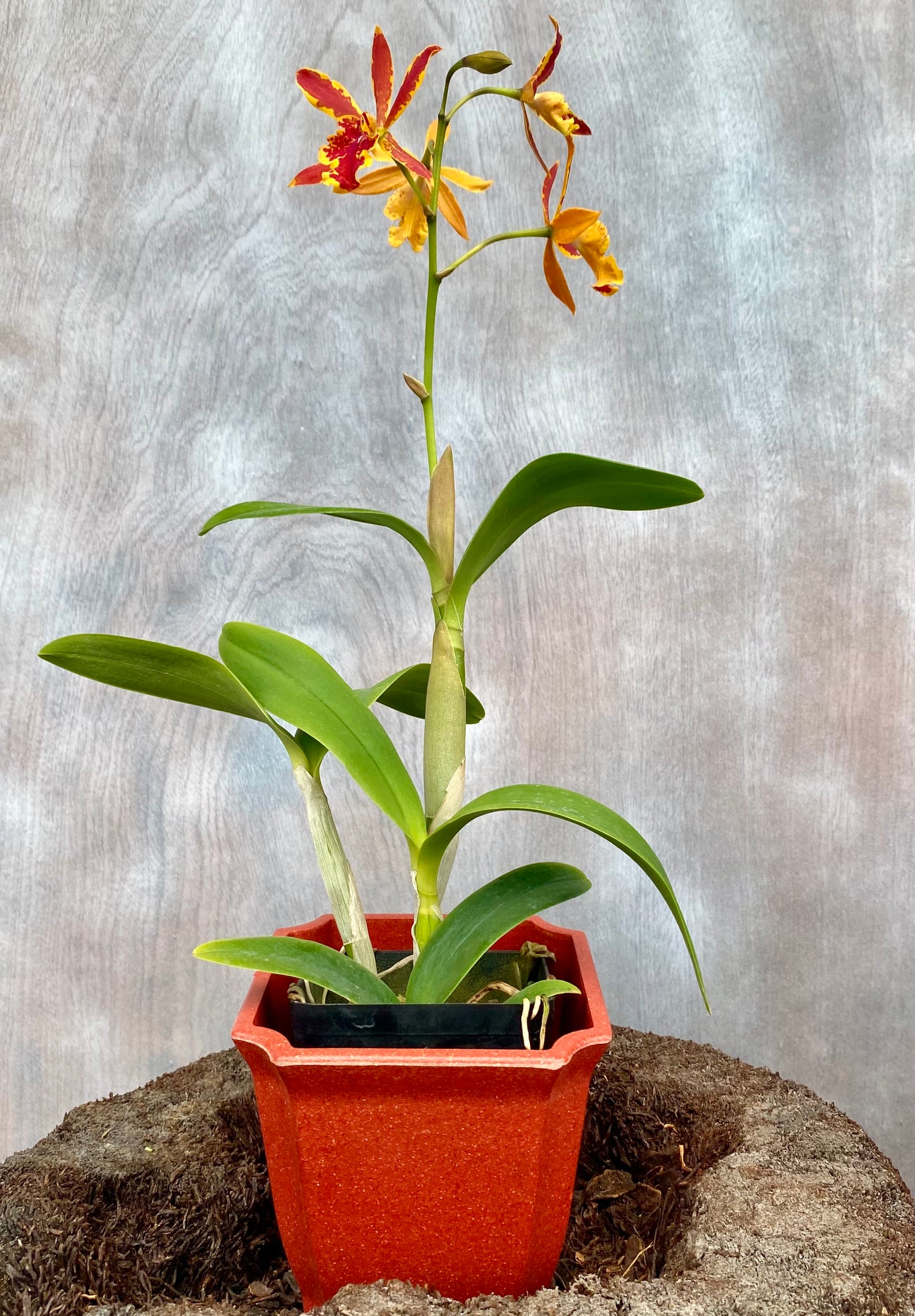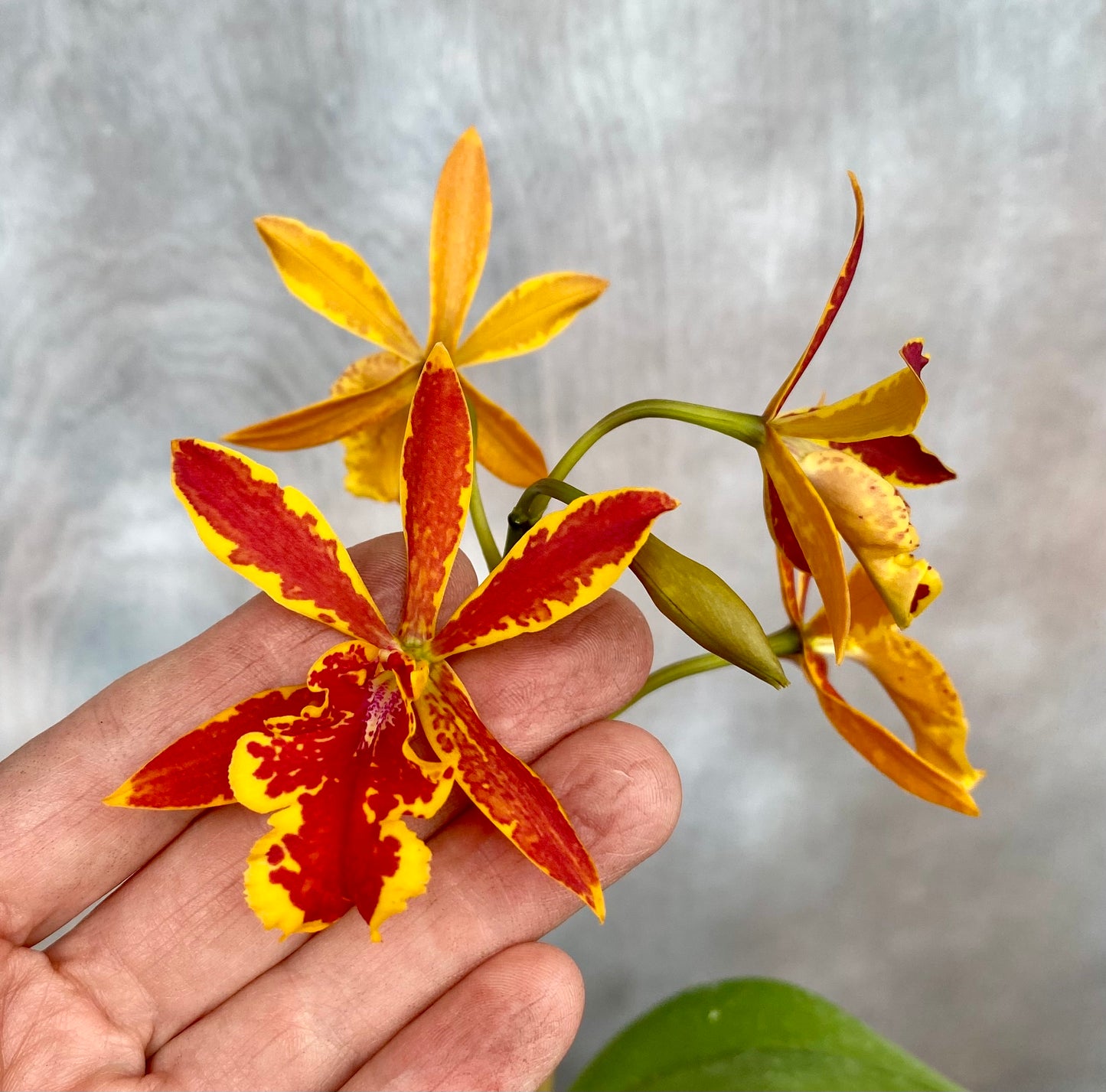Kalapana Orchid Farm
Eplc. Volcano Trick 'Paradise'
Eplc. Volcano Trick 'Paradise'
Couldn't load pickup availability
This orchid is all about a blast of hot, tropical color. Epicatanthe Volcano Trick 'Paradise' erupts with clusters of fiery, star-shaped flowers. Each bloom, about 1.5 to 2 in. across, is a vibrant orange-yellow, generously overlaid with a sizzling reddish-orange blush, especially on the petals and the expressive lip. The flowers are held in abundant clusters atop a tall inflorescence, creating a brilliant, long-lasting display that truly lives up to the "volcano" in its name. It’s a real show-off, and other clones of this same cross, like 'Fireball', have been recognized with an Award of Merit by the American Orchid Society for their outstanding characteristics.
The plant itself has a stately presence, inheriting the tall, cane-like pseudobulb characteristic of its Cattleya and Epidendrum lineage. These pseudobulbs, topped with a pair of durable, leathery leaves, can create a plant that reaches a height of 24-28 in., making a handsome specimen even when out of bloom.
The genetic story of Eplc. Volcano Trick is a fascinating journey through Latin America. It is a hybrid of Cattlianthe Trick or Treat and Epidendrum stamfordianum.
Epidendrum stamfordianum is a warm-growing species found from Southern Mexico down to Venezuela. It lives in seasonally dry forests at low elevations, from sea level up to about 2,600 ft., and is known for producing its flower spike from the base of the pseudobulb, a rather unusual trait.
Cattlianthe Trick or Treat is itself a famous hybrid, drawing its intense orange color from a rich blend of Brazilian species. Its ancestors are tough, sun-loving orchids known as rupicolous, or "rock-growing," Laelias (now classified as Cattleyas). These species include:
Cattleya cinnabarina: Found in the Brazilian states of Minas Gerais and Rio de Janeiro, growing on rocks in bright, exposed conditions at elevations from 2,600 to 5,000 ft.
Cattleya harpophylla: Also from Brazil (Minas Gerais and Espírito Santo), this species grows in shadier, humid habitats at elevations between 1,600 and 3,000 ft.
Cattleya crispata: This species is a true rock-dweller from Minas Gerais, Brazil, found at elevations of 1,300 to 2,600 ft.
The lineage also includes Guarianthe aurantiaca, a hardy species from Mexico and Central America that lives in dry, hilly pastures and forests from 1,000 to 3,600 ft.
This combination of low-elevation warmth from the Epidendrum and the high-altitude, bright-light tolerance of the Brazilian Cattleyas gives Eplc. Volcano Trick 'Paradise' its robust and forgiving nature.
Care Instructions
Light: Provide very bright, indirect light. An east, south, or west-facing window with some shading during the hottest part of the day is ideal. The leaves should be a light, apple-green color.
Water: Water thoroughly and then allow the potting medium to dry out almost completely before watering again. This plant is sensitive to overwatering. When in doubt, wait a day.
Temperature: This orchid is adaptable but prefers intermediate to warm temperatures. Daytime temperatures of 70-85°F with a nighttime drop to 60-65°F will suit it well.
Humidity: A humidity level of 50-70% is ideal. Good air circulation is essential to prevent fungal issues.
Potting Medium: Use a very coarse, fast-draining orchid mix. A blend of large-grade fir bark, charcoal, and perlite or lava rock is an excellent choice. This hybrid can also be grown in a basket or mounted on cork to ensure perfect drainage. Repot every two to three years when the medium starts to decompose.
Beautifully grown in 4" pots.
Share






